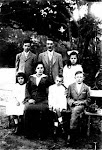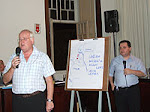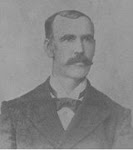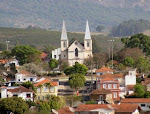Dear Gilberto,


Lem
The Lem family originates from Bruges in Flanders. One of the oldest members of the family, Maertin Lem, his fathers name was also Maertin, settled temporarily in Lisbon in the middle of the fifteenth century1. He was merchant in Lisbon and acted as a banker for king Alfonso V, but Maertin stayed all the time citizen (poorter) of Bruges. In 1463 Maertin was ennobled in Portugal with his own coat of arms. 1450-1485 In 1450 Rombout de Wachtere ordered Maertin Lem to go to Portugal in order to solve a problem between Rombout and two of his agents about the sale of jewels. Therefore Maertin needed letters of recommendation for the Portuguese court. After getting these letters Maertin solved the problems for the time being2. Because Maertin got these orders we may conclude that he was not unknown in Portugal, had been there before and had knowledge about trading. After his introduction at the court his career gained momentum. In 1452 Maertin is mentioned as agent and companion of Zegher Parmentier3 and in 1456 he signed a contract with king Alfonso V and got the monopoly for ten years for the export of cork4. In 1463 Maertin loaned money to the king and supported the siege of Tanger. Furthermore Maertin got permission that same year for himself and his companions to bear weapons5. In 1464 the king legitimated, on demand of Maertin, the seven children (among them another Maertin and an Antonio Leme) of Maertin and his girlfriend Leonor Rodrigues6. In the same year Maertin was ennobled (esqudeiro) and got his own coat of arms. (Tree black ‘merletten’ on a silver shield)7. In 1466, at the end of the contract with king Alfonso V, Maertin went back to Bruges, where Rombout and Maertin started a trial about the jewel case from 14508. This trial lasted till august 1467. In September 1467 Maertin9 became ‘Burgomaster of the corpse’. In the same year he married with Adrienne van Nieuwenhove. The couple got nine children. During the next years Maertin became several times mayor of ‘the corpse’ and of the aldermen. In 1479 he became superintendent of Maximiliaan from Austria10. In 1482 Maertin became, although he was a citizen of Bruges, bailiff of this city. Maertin and Adrienne lived in house Ryckenbuerch were they invited Maximiliaan several times for a dinner party. Maertins position was often contested; the people called him ‘count without a country’ or ‘the little count of Flanders’. During the troubles of 1483 Maertin went to live in Louvain where he died on 27 March 148511. Maertin was, several years later, buried in the chapel of Peter and Paul (also called the Lem chapel) in the church of St. Donaat in Bruges. 1 The name Lem is mentioned before in Bruges and Sint-Winoksbergen, but a connection with this Maertin wasn’t found yet. 2 Civiele sententiën Brugge register 1465-1469; folio 24v; 55v; 132; 66;74; 83; 85v; 87v; 88; 89; 91v-93’132. 3 Civiele sententiën Brugge register 1447-1453; folio 259v. 4 Arquivo Nacional da Torre do Tombo in Lisbon Chancellary of D. Alfonso V, book 13, folio 134. 5 Arquivo Nacional da Torre do Tombo in Lisbon Chancellary of D. Alfonso V, book 9, folio 5. 6 Arquivo Nacional da Torre do Tombo in Lisbon Chancellary of D. Alfonso V, book 8, folio 66 & 67. 7 Livro do Armeire mor 1505. 8 Civiele sententiën Brugge register 1465-1469 several folio numbers see note 3. 9 According to some later authors Maertin the mayor should have been the son of Maertin the merchant and Joanna de Barrosos. This marriage and son Maertin is not documented in primary sources. 10 Dr. Jelle Haemers; for the common good. 11 Nicolaes Despars, van den lande ende graefscepe van Vlaenderen, 1840, IV, page 245. In 1471 Maertin send a boat with soldiers under command of his son Antonio to Portugal in order to participate in the siege of Arzila. For his brave behaviour Antonio was ennobled and he got his own coat of arms for him and his descendants (five black ‘merletten’ on a golden shield). Antonio served several years the Portuguese court before he became merchant and ship owner in Funchal. In Portugal, Maertin Lem was called Martime o’Velho (senior). His son with Leonor Rodrigues was called Martim o’Moco (junior). This Martim o’Moco continued the trade between Portugal and Bruges but died in the same year as his father, 1485. After Maertin (o’Moco)’s death Antonio took over the family business in Funchal. Antonio became the ancestor of the Brazilian Leme family. Portuguese coat of arms (Arquivo Nacional Torrdo Tombo Lisbon) Coat of arms on painting12 Maertin Lem in museum de Potterie. Wil Lem Maastricht, March 14, 2015. Stg. The Lem Family Association Médoclaan 218 6213 EG Maastricht lemspan@gmail.com 12 This is a painting from the seventeenth century made after a painting in the collection of Rapaert de Grass. On both paintings the quarters of the coat of arms are exchanged, see the foundation logo.
In 2008 Margarida Leme published her essay Os Lemes - um percurso familiar de Bruges a Malaca in which she wrote that there was only one Maertin Lem in Portugal and Bruges.
That was the start d a big discussion about the two theories about the relation between Maertin Lem I and II or Maertin the merchant in Portugal and Maertin the politician in Bruges.
In 2013, I have tried to explain these two existing theories about the descent of Maertin Lem.
See annex: Theories about the descent of Maertin Lem.docx.
I also discussed the existence of Joanna Lem.
see annex: phantom Joanna.
This year a collection genealogies made by Johannes Masin (1631-1695) was inventoried and there we found clearly explained that ‘ecoutette' Maertin Lem who was married in Bruges with Adrienne van Nieuwenhove had naturel children with Leonor Rodrigues.
At that moment all the puzzles pieces came together.
Our conclusion in 'Theories about the descent of Maertin Lem' was correct.
With al this information I wrote the history of Maertin Lem, only based on proven facts.
see annex Lem.
Another annex (gezin Maertin) gives Maertin Lem and his children.
I hope this is useful for you on your blog of the Leme family.
When you have any questions, pleas ask.
Kind regards,
Wil
Theories about the descent of Martin Lem
Merchant in Lisbon and Bruges in the fifteenth century
Martin I was the merchant, born in Bruges, living in Lisbon having children with Leonor Rodrigues and leaving Portugal in 1466 for Bruges.
Martin II lived in Bruges, married Adrienne van Nieuwenhove and became ‘burchmeester’ of Bruges and in 1479 counselor of Maximiliaan from Austria.
The big question is what was the relationship between Martin I and Martin II.
Theory A. Martin I and Martin II are father and son.
Martin Lem I was born before 1385 and son of Willem.
Martin I Lem went around 1440 from Belgium to Portugal; married with Joanna de Barrosos and lived in Belgium, their son Martin II was born in Portugal or Belgium.
After the death of Joanna in Bruges, Martin I went back to Lisbon and got 7 children out of his relation with Leonor Rodrigues. These children were legitimated in 1464; the charters of legitimating are still in the royal archives. In 1466 Martin I went back to Bruges.
His son Martin II should has stayed in Bruges, after the death of his mother, where he got his education. Where he stayed in Bruges and whom his guardians were is unknown. He was for the first time mentioned in charters in 1467 when he got married with Adrienne van Nieuwenhove and became mayor of Bruges.
This theory is completely founded on a person, Joanna de Barrosos, which is not documented in historical primary sources. All the information we have comes from later genealogists and historians whose sources are unknown.
The first one who was talking about a lady of de Barrosos family was Manuel de Soeiro in 1625.
Almost 200 years later. Gaillard (ca. 1850) called her: Jeanne…. natif de Portugal.
Theory B. Martin I is the same as Martin II.
In this theory Martin I is the son of the Martin born before 1385 and a grandson of Willem.
It is possible that his mother was Joanna de Barrosos but there is no evidence.
Martin Lem I went around 1450 to Portugal where he had a relation with Leonor Rodrigues.
In 1464 before Martin left Portugal he asked the king to legitimate their children.
Martin was very well known with the court in Portugal and lent money to the king.
In 1466 Martin went back to Bruges where he married Adrienne van Nieuwenhove.
The connection between Martin I and Martin II cannot be found in the primary sources, which are accessible at this moment. Other sources are less reliable and are sometimes in contradiction.
In Bruges are documents from the years 1466/67 about the process between Martin Lem I and Rombout de Wachtere, which are giving good indications.
The problems between Martin I and Rombout are not interesting for our genealogy but the history is.
In 1449/50 Rombout has sent two agents to Portugal to sell jewels. These two agents did not do their job well so Rombout ordered/ asked Martin Lem I to go to Lisbon and look after his affaires.
Martin I went to Lisbon and after some time he needed help. So he asked Rombout for letters of recommendation of the duchess of Flanders (Isabel of Portugal) for her brother the king of Portugal.
This you can still read in these primary documents.
According to Claeys Martin I was in 1450 well known at the court and already a rich and famous merchant. Rombout had contacted the duchess and through her the king for help. The king should have asked Martin I for intervention.
Reality is that Martin was, at that moment (1450), not yet the rich and well known merchant otherwise he would not have accepted an order from Rombout.
He was also not well known at the court because he needed letters of recommendation.
Our conclusion is that this trip in 1450 was one of the first trips of Martin to Portugal. So he was much younger then expected and he cannot be the Martin born before 1385. He could be a son, born around 1420.
He must have started his relation with Leonor short after his arrival because his son Antonio had in 1471 the command over the ship Martin sends from Bruges to Arzila and must have had some age then.
In 1466 Martin I went back to Bruges and from that moment he disappears more or less.
Only in 1470 and 1471 a Martin Lem is mentioned in documents.
In 1470 he is mentioned as a Portuguese merchant, married and living in Bruges.
Only Martin II was then known as merchant and married in Bruges.
In 1471 Martin I was sending a ship with Antonio to Arzila.
Although Martin I and II should have lived together as rich men in the same city, in charters was never made a differentiation between Martin I and II. They always spoke about Martin Lem.
This all indicates that Martin I and Martin II are the same person.
According the statement of Claeys, Martin I never married in Flandres, but this statement cannot be proven because there were no church registers at that time.
In the written sources in Lisbon you will only find something about the family of Martin Lem in 1464 as the king legitimated the children of Martin and Leonor.
We even do not know the birthdays or ages of the children.
Claeys means that son Martin who was legitimated in 1464 was not the son of Leonor Rodrigues but the son of Joanna de Barrosos.
But why should this Martin be legitimated because he was a legitimate child and lived according to Claeys in Bruges.
Our conclusion is that both theories could be true but it is more likely that Martin I and Martin II were the same person.
Wil Lem
Maastricht, 25 march 2013.
The Lem family originates from Bruges in Flanders. One of the oldest members of the family, Maertin Lem, his fathers name was also Maertin, settled temporarily in Lisbon in the middle of the fifteenth century1. He was merchant in Lisbon and acted as a banker for king Alfonso V, but Maertin stayed all the time citizen (poorter) of Bruges. In 1463 Maertin was ennobled in Portugal with his own coat of arms. 1450-1485 In 1450 Rombout de Wachtere ordered Maertin Lem to go to Portugal in order to solve a problem between Rombout and two of his agents about the sale of jewels. Therefore Maertin needed letters of recommendation for the Portuguese court. After getting these letters Maertin solved the problems for the time being2. Because Maertin got these orders we may conclude that he was not unknown in Portugal, had been there before and had knowledge about trading. After his introduction at the court his career gained momentum. In 1452 Maertin is mentioned as agent and companion of Zegher Parmentier3 and in 1456 he signed a contract with king Alfonso V and got the monopoly for ten years for the export of cork4. In 1463 Maertin loaned money to the king and supported the siege of Tanger. Furthermore Maertin got permission that same year for himself and his companions to bear weapons5. In 1464 the king legitimated, on demand of Maertin, the seven children (among them another Maertin and an Antonio Leme) of Maertin and his girlfriend Leonor Rodrigues6. In the same year Maertin was ennobled (esqudeiro) and got his own coat of arms. (Tree black ‘merletten’ on a silver shield)7. In 1466, at the end of the contract with king Alfonso V, Maertin went back to Bruges, where Rombout and Maertin started a trial about the jewel case from 14508. This trial lasted till august 1467. In September 1467 Maertin9 became ‘Burgomaster of the corpse’. In the same year he married with Adrienne van Nieuwenhove. The couple got nine children. During the next years Maertin became several times mayor of ‘the corpse’ and of the aldermen. In 1479 he became superintendent of Maximiliaan from Austria10. In 1482 Maertin became, although he was a citizen of Bruges, bailiff of this city. Maertin and Adrienne lived in house Ryckenbuerch were they invited Maximiliaan several times for a dinner party. Maertins position was often contested; the people called him ‘count without a country’ or ‘the little count of Flanders’. During the troubles of 1483 Maertin went to live in Louvain where he died on 27 March 148511. Maertin was, several years later, buried in the chapel of Peter and Paul (also called the Lem chapel) in the church of St. Donaat in Bruges. 1 The name Lem is mentioned before in Bruges and Sint-Winoksbergen, but a connection with this Maertin wasn’t found yet. 2 Civiele sententiën Brugge register 1465-1469; folio 24v; 55v; 132; 66;74; 83; 85v; 87v; 88; 89; 91v-93’132. 3 Civiele sententiën Brugge register 1447-1453; folio 259v. 4 Arquivo Nacional da Torre do Tombo in Lisbon Chancellary of D. Alfonso V, book 13, folio 134. 5 Arquivo Nacional da Torre do Tombo in Lisbon Chancellary of D. Alfonso V, book 9, folio 5. 6 Arquivo Nacional da Torre do Tombo in Lisbon Chancellary of D. Alfonso V, book 8, folio 66 & 67. 7 Livro do Armeire mor 1505. 8 Civiele sententiën Brugge register 1465-1469 several folio numbers see note 3. 9 According to some later authors Maertin the mayor should have been the son of Maertin the merchant and Joanna de Barrosos. This marriage and son Maertin is not documented in primary sources. 10 Dr. Jelle Haemers; for the common good. 11 Nicolaes Despars, van den lande ende graefscepe van Vlaenderen, 1840, IV, page 245. In 1471 Maertin send a boat with soldiers under command of his son Antonio to Portugal in order to participate in the siege of Arzila. For his brave behaviour Antonio was ennobled and he got his own coat of arms for him and his descendants (five black ‘merletten’ on a golden shield). Antonio served several years the Portuguese court before he became merchant and ship owner in Funchal. In Portugal, Maertin Lem was called Martime o’Velho (senior). His son with Leonor Rodrigues was called Martim o’Moco (junior). This Martim o’Moco continued the trade between Portugal and Bruges but died in the same year as his father, 1485. After Maertin (o’Moco)’s death Antonio took over the family business in Funchal. Antonio became the ancestor of the Brazilian Leme family. Portuguese coat of arms (Arquivo Nacional Torrdo Tombo Lisbon) Coat of arms on painting12 Maertin Lem in museum de Potterie. Wil Lem Maastricht, March 14, 2015. Stg. The Lem Family Association Médoclaan 218 6213 EG Maastricht lemspan@gmail.com 12 This is a painting from the seventeenth century made after a painting in the collection of Rapaert de Grass. On both paintings the quarters of the coat of arms are exchanged, see the foundation logo.








Nenhum comentário:
Postar um comentário